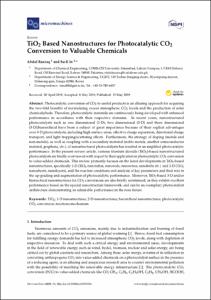Department of Energy Science and Engineering
Green and Renewable Energy for Endless Nature(GREEN) Lab
1. Journal Articles
TiO2 Based Nanostructures for Photocatalytic CO2 Conversion to Valuable Chemicals
- Title
- TiO2 Based Nanostructures for Photocatalytic CO2 Conversion to Valuable Chemicals
- Author(s)
- Razzaq, Abdul ; In, Su-Il
- Issued Date
- 2019-05
- Citation
- Micromachines, v.10, no.5, pp.326
- Type
- Article
- Author Keywords
- TiO2 ; 1-D nanostructures ; 2-D nanostructures ; hierarchical nanostructures ; photocatalytic CO2 conversion ; reactions mechanism
- Keywords
- CARBON-DIOXIDE ; NANOTUBE ARRAYS ; HYDROCARBON FUEL ; ULTRATHIN TIO2 ; THIN-FILMS ; REDUCTION ; PHOTOREDUCTION ; METHANE ; ENHANCEMENT ; HYDROGEN
- ISSN
- 2072-666X
- Abstract
- Photocatalytic conversion of CO2 to useful products is an alluring approach for acquiring the two-fold benefits of normalizing excess atmospheric CO2 levels and the production of solar chemicals/fuels. Therefore, photocatalytic materials are continuously being developed with enhanced performance in accordance with their respective domains. In recent years, nanostructured photocatalysts such as one dimensional (1-D), two dimensional (2-D) and three dimensional (3-D)/hierarchical have been a subject of great importance because of their explicit advantages over 0-D photocatalysts, including high surface areas, effective charge separation, directional charge transport, and light trapping/scattering effects. Furthermore, the strategy of doping (metals and non-metals), as well as coupling with a secondary material (noble metals, another semiconductor material, graphene, etc.), of nanostructured photocatalysts has resulted in an amplified photocatalytic performance. In the present review article, various titanium dioxide (TiO2)-based nanostructured photocatalysts are briefly overviewed with respect to their application in photocatalyticCO2 conversion to value-added chemicals. This review primarily focuses on the latest developments in TiO2-based nanostructures, specifically 1-D (TiO2 nanotubes, nanorods, nanowires, nanobelts etc.) and 2-D (TiO2 nanosheets, nanolayers), and the reaction conditions and analysis of key parameters and their role in the up-grading and augmentation of photocatalytic performance. Moreover, TiO2-based 3-D and/or hierarchical nanostructures for CO2 conversions are also briefly scrutinized, as they exhibit excellent performance based on the special nanostructure framework, and can be an exemplary photocatalyst architecture demonstrating an admirable performance in the near future. © 2019 by the authors.
- Publisher
- Multidisciplinary Digital Publishing Institute (MDPI)
- Related Researcher
-
-
In, Su-Il
- Research Interests CO2 conversion to hydrocarbon fuels; Water splitting for hydrogen generation; Quantum dot devices; Dye sensitized solar cells; Environmental remediation; Synthesis of functional nanomaterials; CO2 연료전환; 수소생산을 위한 광전기화학적 물분해; 양자점 태양전지; 염료감응 태양전지; 공해물질 저감연구; 기능성 나노소재 개발
-
- Files in This Item:
-
 기타 데이터 / 4.77 MB / Adobe PDF
download
기타 데이터 / 4.77 MB / Adobe PDF
download



